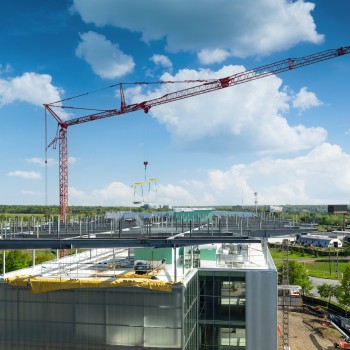In recent years, the construction industry has seen significant advancements in crane technology. These advancements have not only improved the efficiency and safety of crane operations, but they have also opened up new possibilities for the industry. In this article, we will explore the future of cranes and the exciting advancements that are on the horizon.
Introduction: The Evolution of Cranes and What Lies Ahead
Cranes have come a long way since their humble beginnings. Originally used for lifting heavy objects, these machines have evolved to become essential tools in construction and other industries. The early cranes were operated manually, requiring a great deal of physical strength and effort. However, with advancements in technology, cranes have become more sophisticated and efficient. Modern cranes are equipped with hydraulic systems and computerized controls, allowing for precise and safe lifting operations. Looking ahead, the future of cranes seems promising. With the rise of automation and artificial intelligence, we can expect to see even more advanced and intelligent cranes that can perform complex tasks with minimal human intervention.
Cutting-Edge Technologies: How Robotics is Revolutionizing the Crane Industry

The crane industry is undergoing a major transformation thanks to cutting-edge robotics technologies. These advancements are revolutionizing the way cranes are operated and improving efficiency and safety in construction sites. One of the key innovations is the development of autonomous cranes that can perform tasks without human intervention. These cranes are equipped with advanced sensors and artificial intelligence algorithms that allow them to navigate complex environments and make real-time decisions. This not only reduces the risk of accidents but also increases productivity by eliminating the need for human operators. Additionally, robotics technologies are enabling cranes to perform tasks that were previously impossible or highly challenging, such as lifting heavy loads with precision and accuracy. Overall, the integration of robotics in the crane industry is reshaping the way construction projects are carried out, making them faster, safer, and more efficient.
Sustainable Solutions: Exploring Eco-Friendly Innovations in Crane Design
In recent years, there has been a growing focus on sustainability and eco-friendly practices in various industries. One area that has seen significant advancements in this regard is crane design. Cranes are essential equipment in construction and other heavy industries, but their traditional designs often come with high energy consumption and environmental impact. However, innovative companies are now exploring sustainable solutions to address these issues. These eco-friendly crane designs incorporate features such as energy-efficient motors, regenerative braking systems, and lightweight materials. By reducing energy consumption and emissions, these innovations not only contribute to a greener future but also offer cost savings for businesses.
Enhanced Safety Measures: The Latest Breakthroughs in Crane Operator Protection
Crane operators play a crucial role in construction and other industries, but their job can be dangerous. That’s why enhanced safety measures are constantly being developed to protect these workers. The latest breakthroughs in crane operator protection include advanced safety systems such as anti-collision technology, which uses sensors to detect potential collisions and automatically stops the crane. Another innovation is the use of virtual reality training, which allows operators to practice their skills in a simulated environment before operating a real crane. Additionally, improved cabin designs with better visibility and ergonomic features help reduce operator fatigue and improve overall safety. These advancements are essential in ensuring the well-being of crane operators and preventing accidents on worksites.
Smart Crane Systems: Harnessing the Power of Artificial Intelligence for Improved Efficiency
Smart crane systems are revolutionizing the construction industry by harnessing the power of artificial intelligence (AI) to improve efficiency. These advanced systems use AI algorithms to analyze data and make real-time decisions, allowing cranes to operate more efficiently and safely. By utilizing AI, smart crane systems can optimize load distribution, reduce energy consumption, and minimize downtime. Additionally, these systems can detect potential hazards and automatically adjust crane operations to prevent accidents. With the ability to learn and adapt, smart crane systems are transforming the way construction projects are executed, leading to increased productivity and cost savings.
Beyond Construction: The Promising Applications of Cranes in Various Industries
Cranes have long been associated with the construction industry, but their applications extend far beyond that. In recent years, cranes have found promising uses in various industries, revolutionizing the way work is done. One such industry is the shipping and logistics sector, where cranes are used to load and unload heavy cargo from ships. This not only speeds up the process but also reduces the risk of damage to the goods. Additionally, cranes have become indispensable in the manufacturing industry, where they are used to lift and move heavy machinery and equipment. This improves efficiency and ensures the safety of workers. With their versatility and adaptability, cranes are proving to be valuable assets in a wide range of industries.
Conclusion
In conclusion, the future of cranes looks promising with the advancements on the horizon. The integration of artificial intelligence and automation technology will revolutionize the industry, making cranes more efficient and safer to operate. With these advancements, we can expect to see increased productivity and reduced costs in construction projects, ultimately benefiting both workers and businesses.
What are some advancements in crane technology?
Some advancements in crane technology include the use of automation and robotics, improved safety features, increased lifting capacity, and enhanced control systems.
How does automation benefit crane operations?
Automation in cranes allows for increased efficiency, reduced human error, and improved productivity. It also enables remote operation and monitoring, making it easier to control and manage crane operations.
What safety features have been developed for cranes?
Several safety features have been developed for cranes, such as anti-collision systems, load monitoring systems, emergency stop buttons, and advanced warning systems. These features help prevent accidents and ensure the safety of both operators and bystanders.
How has lifting capacity improved in modern cranes?
Lifting capacity in modern cranes has significantly improved due to advancements in materials, engineering, and technology. Cranes can now lift heavier loads and reach greater heights, making them more versatile and capable of handling a wider range of tasks.
What are the benefits of enhanced control systems in cranes?
Enhanced control systems in cranes provide operators with better precision, accuracy, and control over crane movements. This improves overall operational efficiency and reduces the risk of accidents or damage to the load being lifted.
What is the future of crane technology?
The future of crane technology is likely to involve further automation, integration with digital systems, and the use of artificial intelligence. This will lead to even greater efficiency, safety, and productivity in crane operations.

